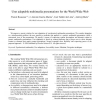1863 search results - page 17 / 373 » The Case for Design Using the World Wide Web |
EUSFLAT
2007
13 years 8 months ago
2007
Finding sequential patterns is one of important issues in data mining. This paper deals with linguistic (fuzzy) sequential patterns. The existing algorithms for discovering such p...
CN
1999
13 years 7 months ago
1999
We propose a generic solution for user adaptation of synchronized multimedia presentations. We consider adaptation as a transformation problem: the user specifies a predicate that...
COSIT
1995
Springer
13 years 11 months ago
1995
Springer
The World Wide Web (WWW) is a rapidly growing distributed hypertext on the Internet. This paper presents a way to enable users to navigate the WWW spatially by providing a spatial...
AI
2000
Springer
13 years 7 months ago
2000
Springer
The World Wide Web is a vast source of information accessible to computers, but understandable only to humans. The goal of the research described here is to automatically create a...
ICEIS
2000
IEEE
13 years 11 months ago
2000
IEEE
The world-wide-web does not support referential integrity, i.e. dangling references do exist. This can be very annoying; in particular, if a user pays for some service in the form...

